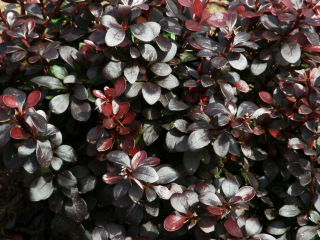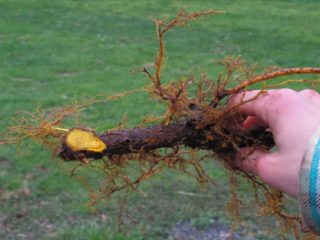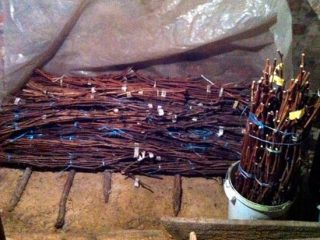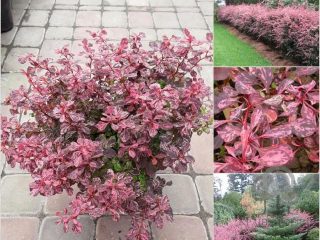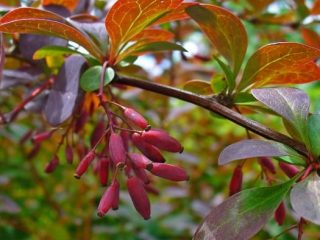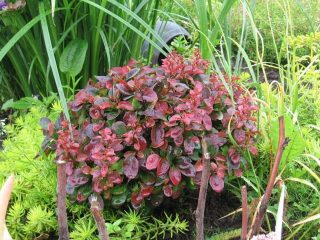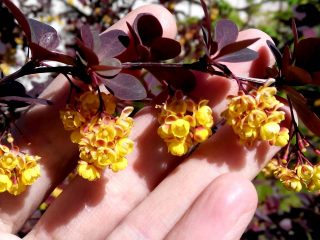Content
Barberry is a garden plant that is used for fruit production and for decorative purposes. The shrub is unpretentious and easy to care for, but it is susceptible to pests of fruit and berry plants. Barberry diseases and the fight against them, photos of lesions are presented below, begin from the moment the bush is planted.
Reasons why barberry dries
If everything is in order with watering in your garden plot, pests or diseases may be the cause of barberry drying out. Most often, the leaves dry out and fall off when the bush is infested with aphids. This pest literally sucks all the juices from the branches of the plant.
Another reason for drying out of a shrub can be a fungal infection. There are several types of them. Each one manifests itself in its own way. If the leaves of a plant are affected, tracheomycosis wilt can be suspected. This is a fungus that destroys the root system. The bush is deprived of natural nutrition and begins to dry out.Leaf diseases in barberry are common.
Why doesn't barberry bloom?
The reason for the lack of flowers on barberry in the spring may be winter freezing of the buds. Excessive watering can also cause this condition. If the soil is too moist, a fungal disease is suspected. It develops in soils where there is stagnant water. Therefore, before planting, it is important to make drainage in the crushed stone hole. After watering, it is important to fluff up the soil well.
Young plants that have not adapted to the new location may not bloom. Good rooting of a seedling does not mean that the bush has taken root. He needs time.
To exclude diseases and pest attacks, the bush is carefully inspected; if there is no damage, another cause should be looked for.
Aphids and caterpillars can damage the peduncle even in its infancy. Aphids are an aggressive pest that sucks all the juices out of the bush, leaving no energy left to fight and bloom.
Diseases of barberry bushes and their treatment
Barberry is often used as an ornamental plant that grows well and blooms luxuriantly. But it is susceptible to fungal diseases, which greatly reduces its decorative qualities.
If the shoots or buds are damaged at the slightest by pests, flowering will not occur. Mostly, diseases affect the leaves and branches of the tree, less often the root. At the same time, the foliage turns yellow and crumbles, the branches dry out and wither. This plant does not have any decorative function.
Powdery mildew on barberry
Common barberry is more susceptible to this disease than all other species. In mid-summer, a white, powdery coating appears on both sides of barberry leaves - this is how mycelium is formed. As it develops, it becomes denser and covers the entire surface of the leaf and shoots. If you do not use known methods of combating fungal diseases, the mycelium will cover the entire bush.
Traditional methods of combating barberry fungal disease are simple. In early spring, before the buds swell, the bush is evenly doused with boiling water. Water the plant thoroughly so that the liquid gets on every shoot and twig.
Another effective method of combating fungal diseases is spraying with a soda-soap solution. It is prepared as follows: 0.5% soda ash and 40 g of soap are diluted in 10 liters of water. The bushes are sprayed with this solution 3 times per season.
The next effective method of combating powdery mildew is spraying with modern insecticides. The most famous and accessible drug is Bordeaux mixture. The plant is treated in early spring and late autumn.
Rust on barberry
Barberry disease - rust appears as bright orange spots on the surface of the leaf. On the reverse side you can see a convex yellow-hot formation - fungal spores. The fight against this disease begins as early as possible.
Effective control methods: tearing off and burning affected leaves, spraying the bush with fungicides and Bordeaux mixture. The plant is treated with it immediately after the leaves appear, then 2 more times at intervals of 1.5 weeks.
spotting
Barberry suffers from all types of spotting: gray, white, brown and others.This disease appears on the leaves in the form of rusty or brown spots that resemble burns. Sometimes spotting on barberry looks like a white coating. When the disease affects the entire plant, it looks like a dried out shrub. It is not immediately possible to determine the cause.
Fungicides are considered an effective method of combating all types of spotting. Modern drugs quickly and easily destroy the disease.
Fruit bushes are sprayed with substances containing copper, or traditional methods of combating spotting are used.
Drying of the bark and crown
The disease manifests itself as cracking and falling off of the bark. The crown turns yellow and dries out. Fungal spores appear at the site where the bark cracks. These areas must be removed urgently so that the plant does not die. Only the lower part of the bush with shoots and buds is left.
Control methods: the affected branches are cut off, the cut areas are treated with garden varnish. The entire bush is treated with copper sulfate. It is sprayed, carefully and thickly sprinkling each shoot and leaf.
Bacteriosis
The disease on Thunberg barberry and its other species manifests itself as dark spots that form on young shoots and leaves of the bush. Later they die, and swelling appears at the site of the lesion. To combat bacteriosis, cut off the affected areas and burn them. Buying a healthy seedling from a nursery is a good prevention of dysbacteriosis.
Treatment is carried out by spraying. To do this, copper oxychloride (40 g) is diluted in 10 liters of water. The shrub is treated with this solution twice per season.
Barberry pests and ways to combat them
Decorative and fruiting barberry is a real treat for insects. The juice of its shoots attracts pests to the garden.Yellow leaves covered with holes and spots, damaged shoots of the plant are a sign not only of disease, but also of insect damage. When the first signs appear, pest control begins. This is the only way to save the plant.
Methods for controlling caterpillars on barberry
Yellow, curled, falling leaves are a sign of damage by caterpillars, scale insects, and sawflies. Pest control is carried out using traditional and chemical methods.
To prevent the appearance of caterpillars, trim the bushes in a timely manner. Affected leaves are burned.
It is important to carry out autumn pruning and spraying. Caterpillars often leave larvae under the bark and in the leaves of barberry for the winter. Summer spraying is carried out a month before the fruits of the bush ripen. An effective means of combating caterpillars is Chlorophos.
One of the traditional methods of pest control for this crop is spraying with wormwood tincture. You can also get rid of insects by fumigation. To do this, wet straw is laid out next to the bush, collecting it in a heap. 5 kg of tobacco is poured on top and set on fire. The duration of the procedure is 1 hour or a little more. Plants are fumigated in calm weather. They try to ensure that the smoke reaches the infected bush.
Methods for controlling aphids
Dried and curled leaves, deformed shoots are a sign of aphid damage to barberry. The insect settles on the bottom of the leaf near the cuttings. In a short time it produces numerous offspring. The aphid sucks the juices out of the plant and it dies. Already in early spring, these insects can be seen on the buds of the bush. Below is a photo of the barberry pest and signs of the disease it causes.
Folk recipes for fighting aphids on barberry:
- spring treatment with a solution of laundry soap;
- spraying with garlic infusion;
- treating the plant with tincture of tobacco or horse sorrel.
A modern effective method of pest control is considered to be spraying shrubs with sulfur-containing preparations: Fitoverm, Aliot, Kinmiks.
Preventive measures to prevent diseases and pests of barberry
Most varieties of this crop are resistant to diseases and insect damage. Improper care, irregular watering and pruning make the plant vulnerable to various diseases. The fight against them begins with proper prevention.
Mushrooms appear on moist, acidified soils. Good drainage and fertilizing the bush with ash will prevent the growth of mycelium.
For planting barberry, only proven seedlings from nurseries are used. This way you can avoid buying a diseased plant infected with fungus.
Rules for the prevention of diseases of yellow barberry and other species:
- Shrubs should not be planted close to each other. When planting, follow the recommendations of agricultural technicians on the location of plants.
- In humid climates, the garden should be well ventilated. Fogging of the root system and trunk circle should be avoided.
- To prevent the fight against fungal diseases, avoid drying the barberry root. This makes it vulnerable to fungal diseases.
- Periodic feeding of the crop with mineral and organic fertilizers increases the plant's resistance to diseases and pests.
- Spring and autumn sanitary pruning does not allow insect larvae to reproduce in the bark of dead shoots.
- Regular inspection of the bush will help to identify the disease at an early stage and begin to fight it in time.
Autumn garden cleaning is one of the methods for preventing bush plant diseases. Fallen leaves and pruned branches of bushes are raked into piles and then burned. Harmful insects lay larvae in plant debris, and in the spring the young growth destroys garden plants. Thus, they will have nowhere to winter.
Conclusion
Garden diseases of barberry and the fight against them, a photo of a healthy shrub is presented below, should begin in the fall.
After harvesting, wilted plants in the garden are destroyed and the shrubs are prepared for winter. How the plant overwinters determines its health in the new season. Insects are destroyed even before flowering begins, so as not to interrupt the fruiting of the crop. Pest and insect control should begin immediately at the first sign of plant damage.












